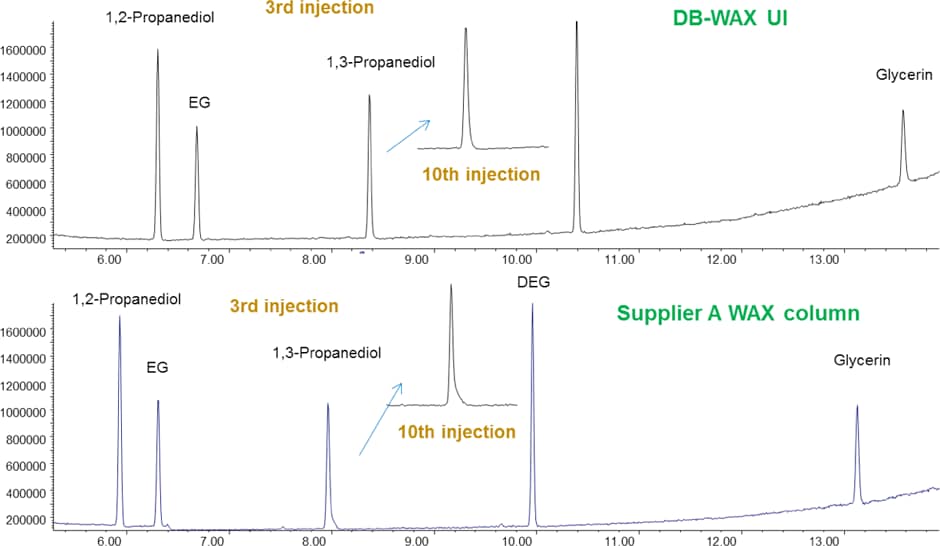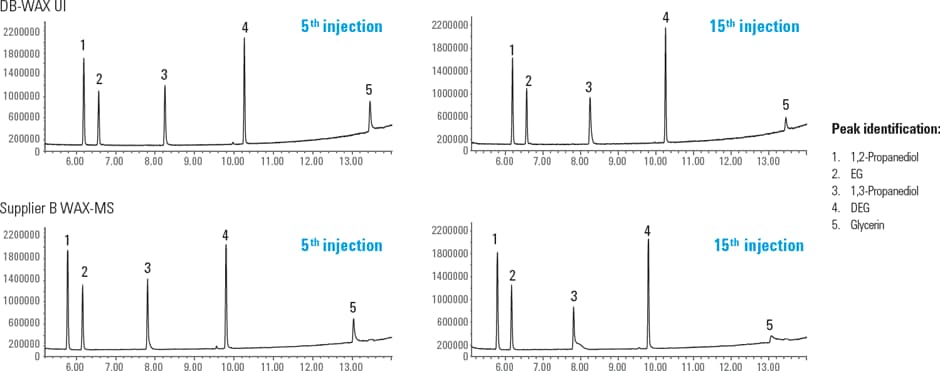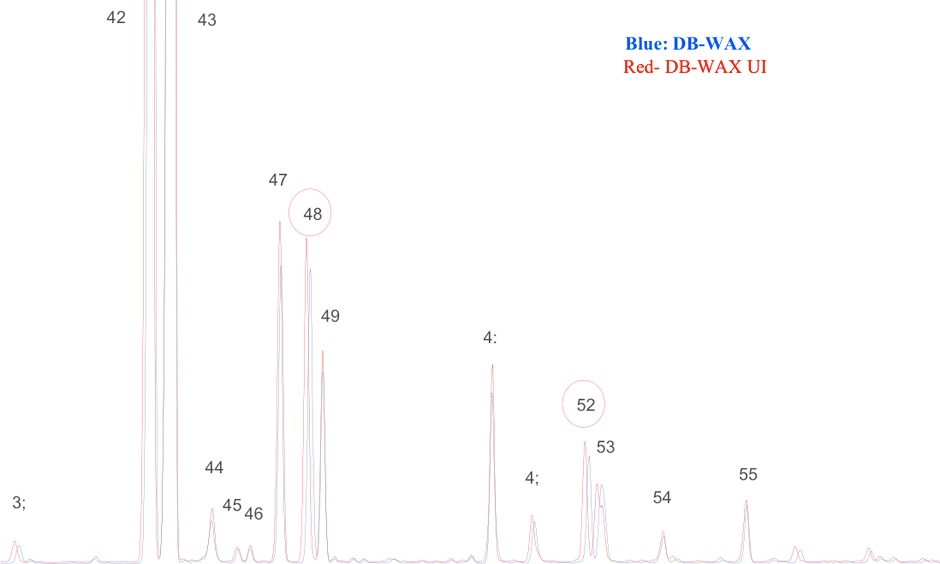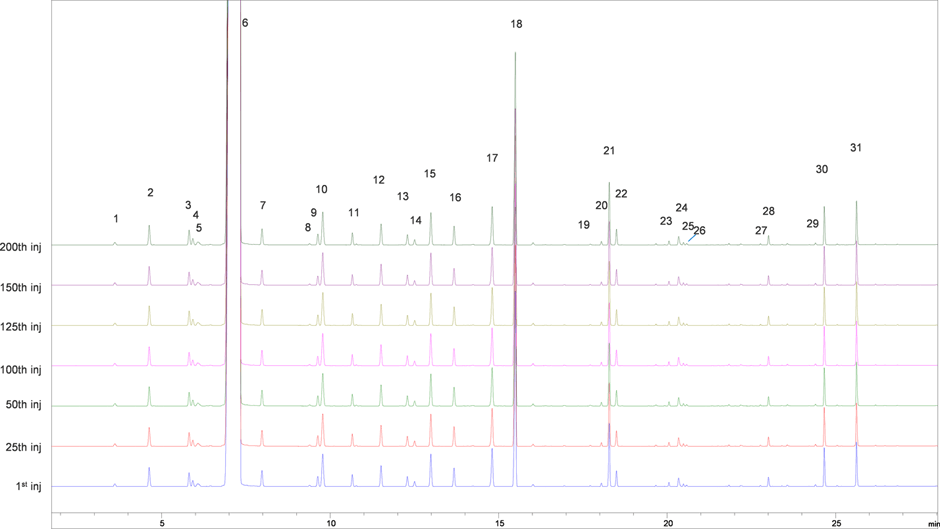Access Agilent eNewsletter June 2016

Excellent inertness for analysis of challenging polar compounds
Yun Zou, Agilent GC Columns Applications
GC and GC/MS detector technology now pushes the limits of detection to the parts-per-billion and parts-per-trillion levels. As these detectors can only detect the analytes that reach them, the activity of the flow path plays a critical role in GC and GC/MS analysis outcomes. Active sites within the flow path can adsorb or catalytically decompose labile analytes, which causes peak tailing and signal loss. The Agilent J&W Ultra Inert GC column family pushes industry standards for consistent column inertness, resulting in lower detection limits and more accurate data for difficult analytes.
Performance tested against the strictest QC standards
New Agilent J&W DB-WAX Ultra Inert columns overcome the persistent inertness problems of standard polyethylene glycol (PEG) columns. All DB-WAX Ultra Inert columns are individually tested with an Ultra Inert Wax test probe mixture according to the strictest industry QC standards. This ensures consistent column-to-column inertness performance for challenging active analytes such as free fatty acids, alcohols, diols, and aldehydes—with minimal compound adsorption or degradation. Having the same selectivity as the Agilent J&W DB-WAX GC column makes upgrading to Ultra Inert performance easy with minimal validation.
Three new Agilent application notes, 5991-6637EN, 5991-6635EN and 5991-6638EN confirm the excellent inertness performance of Agilent J&W DB-WAX Ultra Inert columns.

Figure 1. Chromatograms of a 0.1 mg/mL test mixture of DEG, 1,2-Propanediol, Ethlyene Glycol (EG), 1,3,-Propanediol and glycerin, resolved on an Agilent J&W DB-WAX UI and a WAX column from supplier A.

Figure 2. Chromatograms of a 0.1 mg/mL test mixture of DEG, 1,2-Propanediol, Ethlyene Glycol (EG), 1,3,-Propanediol and glycerin, resolved on an Agilent DB-WAX UI and a WAX column from supplier B.

Figure 3. Overlay of a section the GC/MS chromatogram of lavender oil. Agilent J&W DB WAX (blue) and Agilent J&W DB-WAX UI 30 m x 0.25 m, 0.25 µm (red). Showing that highly active compounds such as terpinen-4-ol (peak 26) and α-terpineol (peak 30) exhibit excellent peak shape and better response on the DB-WAX UI GC column.

Figure 4. Overlaid GC/FID chromatograms of repeat injections of the Chinese liquor sample. Alcohol, aldehyde and organic acid peaks are sharp and well-defined.
Improved and more reproducible peak shapes
Agilent J&W DB-WAX Ultra Inert (UI) columns were used for a GC/MSD analysis of organic solvents— ethylene glycol (EG) and diethylene glycol (DEG)—in toothpaste. The multiple active hydroxyl functional groups found in those compounds make it difficult to achieve good peak shapes during its analysis. Figure 1 demonstrates that when using an Agilent J&W DB-WAX UI column, symmetrical peak shapes were achieved for highly active compounds, including EG and DEG—indicating a high level of column inertness. We compared the performance of the Agilent J&W DB-WAX UI column with other vendor’s WAX columns. Figures 1 and 2 show that good performance was achieved in the first analysis on each WAX column, with the performance of the supplier A and B columns being similar to that of the Agilent J&W DB-WAX UI column. However after 10 injections, there was noticeable tailing and reduced response of 1,3-propanediol in the chromatograms for supplier A and B columns. In contrast, high inertness and improved thermal longevity of the Agilent J&W DB-WAX UI column provided better peak shape and more reproducible analytical results for these active compounds.
Consistent selectivity with improved sensitivity
In another study, lavender oil samples were evaluated using GC-FID and GC/MS. Thirty-six major components of the lavender oil samples were identified. The same selectivity was achieved with both Agilent J&W DB-WAX and J&W DB-WAX UI columns, as illustrated in Figure 3. However the Agilent J&W DB-WAX UI column provided better peak shape and improved sensitivity for active compounds because of its improved inertness. Due to the same selectivity, no additional method development or validation is needed when switching to an Agilent J&W DB-WAX UI column to replace a DB-WAX column.
Excellent performance with challenging samples
A third study included the analysis of distilled spirits. This analysis was challenging because of the high levels of water in the samples (40-80%). Traditional PEG columns had shortcomings with more chemically active components in the alcohol/water matrix and were unstable with aqueous samples. The inertness of the Agilent J&W DB-WAX UI column ensured that excellent resolution and peak shape was achieved for challenging polar compounds, including alcohols, aldehydes and organic acids. Figure 4 shows the overlaid FID chromatograms of 200 injections of Chinese liquor sample on the Agilent J&W DB-WAX UI column, illustrating the excellent reproducibility in retention time and peak shape--overcoming many of the traditional shortcomings of PEG columns.
Ensure better results with Agilent Inert flow path solutions
Agilent J&W DB-WAX Ultra Inert GC columns deliver excellent inertness with more reliable peak shape and better longevity than competitive WAX columns. By minimizing activity along every step of the GC and GC/MS flow path Agilent Inert Flow Path Solutions improve system performance, ensure better results and allow you to process more samples without unplanned maintenance and recalibration. To learn more, watch our video A View of the Inert Flow Path.
For Research and Quality Control Use Only. Not for use in diagnostic procedures.
This information is subject to change without notice.
Stay informed about the applications that are important to you
Subscribe to Access Agilent
Our free customized
monthly eNewsletter
All articles in this issue
 New Agilent 8900 ICP-QQQ delivers increased sensitivity, improved accuracy, and higher productivity
New Agilent 8900 ICP-QQQ delivers increased sensitivity, improved accuracy, and higher productivity New Agilent 1260 Infinity II LC system delivers higher level of operational efficiency
New Agilent 1260 Infinity II LC system delivers higher level of operational efficiency Robust Agilent 6470 Triple Quadrupole LC/MS delivers confident quantification and streamlined workflows
Robust Agilent 6470 Triple Quadrupole LC/MS delivers confident quantification and streamlined workflows Achieve accurate analysis of sulfur and nitrogen with the new and simplified Agilent 8355 SCD
Achieve accurate analysis of sulfur and nitrogen with the new and simplified Agilent 8355 SCD Agilent 1290 LC and 6550 iFunnel Q-TOF combine to provide fast, high-resolution peptide mapping of innovator and biosimilar mAbs
Agilent 1290 LC and 6550 iFunnel Q-TOF combine to provide fast, high-resolution peptide mapping of innovator and biosimilar mAbs Agilent collaborates with Academia—from investigating arsenic mysteries to understanding the complexity of biology
Agilent collaborates with Academia—from investigating arsenic mysteries to understanding the complexity of biology Excellent inertness for analysis of challenging polar compounds
Excellent inertness for analysis of challenging polar compounds Detection of semivolatile extractables and leachables (E&Ls) found in pharmaceutical products
Detection of semivolatile extractables and leachables (E&Ls) found in pharmaceutical products Agilent multi-omics solutions unravel the effects of low-level gamma radiation on rice seeds
Agilent multi-omics solutions unravel the effects of low-level gamma radiation on rice seeds Agilent comprehensive water screening solution reliably identifies wastewater contaminants of emerging concern:
Agilent comprehensive water screening solution reliably identifies wastewater contaminants of emerging concern:
A real-life application
Figure 1

Chromatograms of a 0.1 mg/mL test mixture of DEG, 1,2-Propanediol, Ethlyene Glycol (EG), 1,3,-Propanediol and glycerin, resolved on an Agilent J&W DB-WAX UI and a WAX column from supplier A.
Figure 2

Chromatograms of a 0.1 mg/mL test mixture of DEG, 1,2-Propanediol, Ethlyene Glycol (EG), 1,3,-Propanediol and glycerin, resolved on an Agilent DB-WAX UI and a WAX column from supplier B.
Figure 3

Overlay of a section the GC/MS chromatogram of lavender oil. Agilent J&W DB WAX (blue) and Agilent J&W DB-WAX UI 30 m x 0.25 m, 0.25 µm (red). Showing that highly active compounds such as terpinen-4-ol (peak 26) and α-terpineol (peak 30) exhibit excellent peak shape and better response on the DB-WAX UI GC column.
Figure 4

Overlaid GC/FID chromatograms of repeat injections of the Chinese liquor sample. Alcohol, aldehyde and organic acid peaks are sharp and well-defined. Retention time reproducibility is excellent over the course of 200 largely aqueous (62% by volume) injections of a neat Chinese liquor sample. Peak shapes for problematic analytes are symmetrical and consistent throughout the study. The Agilent DB-WAX UI column shows superior inertness and phase stability.